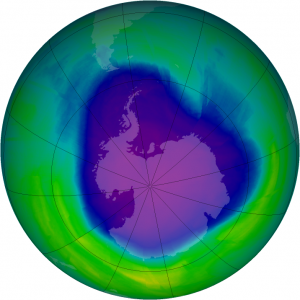The benefits of strong and effective chemical regulation:
Case studies of chemical management
Chemical regulation plays a pivotal role in safeguarding human health, preserving the environment, and promoting sustainable practices.
The need for action is urgent and the benefits of strong and effective chemical regulation are clear. Throughout history, there have been remarkable stories that showcase the significant impact of effective chemical regulation. These examples highlight how proactive and stringent regulatory measures can lead to healthier societies, cleaner ecosystems, and economic benefits, but also that in some cases there is a need for greater and more urgent regulatory attention.

CFCs: historic environmental recovery
In the 1970s, evidence emerged of the potential for chemicals used in our everyday items to deplete the Earth’s ozone layer, an atmospheric layer that shields the Earth’s surface from ultraviolet radiation1. This was later confirmed in the 1980s following the discovery of an ‘ozone hole’ over Antarctica2. The main culprit identified was the chemical group, chlorofluorocarbons (CFCs), commonly used in aerosols, refrigerants, and solvents. Two years after the discovery of the ozone hole, the Montreal Protocol on Substances that Deplete the Ozone Layer was in place and negotiated drastic reductions in CFC use across the globe3. In 1990, the protocol was strengthened and enforced a ban on CFCs in industrialised countries by 2000, and in developing countries by 2010. Following ratification of 197 countries and a 98% compliance rate, the protocol is universally credited for a now recovering ozone layer3,4,5. The Montreal Protocol remains one of the most celebrated international environmental treaties to date, successfully using the essential use concept and providing demonstrable evidence of what effective regulation and meaningful action can achieve when faced with environmental crises.
PCBs: the need for a grouping approach
Polychlorinated biphenyls (PCBs) have been connected with health concerns for both people and wildlife, including adverse effects to the immune system, nervous system, hormonal function, reproduction and cancer6,7,8. This group of highly persistent and toxic chemicals were used in numerous industrial and commercial applications globally. Production of PCBs was banned in the United States in 1979 by the Toxic Substance Control Act (TSCA)6. In 2004, PCBs were also listed as Persistent Organic Pollutants (POPs) under the Stockholm Convention, banning any further production and requiring ratified countries to eliminate their use in equipment by 20259. Whilst the deadline for phase-out under the Stockholm Convention draws closer, earlier action taken in the US has resulted in notable change. Studies monitoring PCBs in harbour seals in North America’s Salish Sea recorded an 81% decline in concentrations levels between 1984 and 200310. Researchers attributed the decline to successful regulation which noticeably reduced contamination within the Salish Sea, and thus the risk of harm to local marine life. Multiple reports of declining PCB concentrations in human breast milk recorded across Europe, North America and Asia also provides a promising indication of international efforts to halt further PCB pollution11. Whilst regulation is starting to have an impact, the PCB case study highlights the need for greater and more urgent regulatory attention regarding persistent chemicals. A preventative and precautionary approach would provide more effective protection for human health, the environment, and the economy.


PFOS and PFOA: a case of regrettable substitution
Per- or poly-fluorinated alkyl substances (PFAS) are a group of over 4,700 industrial chemicals used in many everyday products. PFAS have been subject to increasing international scrutiny and regulation following evidence of extreme persistence, and growing health and environmental concerns12. Two of the most well studied and most heavily regulated PFAS include Perfluorooctane sulfonate (PFOS) and perfluorooctanoic acid (PFOA). Both are classified as POPs under the Stockholm Convention and have been subject to various additional restrictions by individual countries. Regulation, complimented by voluntary phase-outs from some industry representatives, has resulted in a consistent decline in PFOS and PFOA in human biomonitoring studies. Belgium, Denmark, Germany, Sweden and Australia have all recorded decreased levels over the past 10-20 years, largely attributed to the phase out of PFOS and PFOA in consumer products13,14,15,16. Whilst some levels recorded still exceed recommended health limits, these findings support a unified regulatory approach and highlight the need for early action on persistent chemicals. As all PFAS are prone to extreme persistence, restrictions should extend to cover the full PFAS group to prevent cases of regrettable substitution.
Herbicides and Pesticides
A 2017 report by the European Commission assessed the health and environmental benefits of chemical legislation, covering a wide range of case studies17. Herbicide and pesticide regulations were repeatedly highlighted as success stories. Findings of atrazine, a herbicide recognised as an Endocrine Disrupting Chemical (EDC), has reportedly fallen from more than 60% of analyses to 15% for water quality18. A significant proportion of this decline was attributed to an EU ban on atrazine19. Research into trends towards less hazardous pesticides was used as a proxy for environmental recovery from harmful alternatives. Findings indicated a shift from known substances of concern, such as organochlorines and organophosphates which fell from a 25% representation of insecticides used in 1990, to 12% in 201317. These declines also align with associated regulations. The report determined that “without pesticide legislation, processes and policy, the exposure of wildlife to potentially hazardous pesticides, and their subsequent impact on aerial species would be much higher for a longer period of time”17.

Economic Benefits of Chemical Regulation
EU REACH Cost Savings
EU REACH aims to provide high levels of human and environmental protection through effective chemical regulation. EU REACH regulations were adopted into UK law in January 2021, under the European Union (Withdrawal) Act 2018, and are now managed under UK REACH20. Analysis of the financial benefits of EU REACH are well documented. A report by the European Consumer Organisation (BEUC) and Friends of the Earth Europe quotes savings of €6.9-34.4 billion in health costs, and €3.4-10.9 billion in drinking water purification and sewage sludge disposal costs from REACH regulations21. Early action also provides benefits in preventing future chemical crises. The environmental cost of polychlorinated biphenyls (PCBs) for example was estimated to be at least €15 billion across EU25 (pre-2007 EU Member States)22. These benefits and cost savings far outweigh the costs of implementing REACH, estimated between €2-7 billion21.
Future-proofing Businesses
There is growing industry, investor, and consumer interest in sustainable chemical management practises. Some of the UK’s leading retailers have taken voluntary action to move away from harmful chemicals, such as PFAS and bisphenols, in an effort to futureproof their businesses22, 23. In a survey conducted by Fidra, 100% of retailers who had voluntary removed bisphenols from their paper receipts quoted ‘futureproofing against future legislation’ and ‘human health’ as key motivations; 75% also listed ‘environmental impacts’24. The International Chemical Secretariat, ChemSec, have also showcased growing international support from industries and investors to phase out harmful chemicals. ChemSec coordinates the Investor Initiative on Hazard Chemicals (IIHC), a network of over 50 investors, representing US $11 trillion in assets, dedicated to reducing the impacts of hazardous chemicals25.
The impact of chemical content must also be considered within a circular economy. Numerous case studies have demonstrated how the continued use of chemicals of concern can leave recycling efforts vulnerable to contamination with newly restricted or otherwise harmful substances. These include, bisphenol-A (BPA) found in recycled napkins and toilet paper, PFAS found in food packaging labelled as recyclable or compostable, and flame retardants found in recycled plastic products such as kitchen utensils and toys26,27,28. Effective chemical regulation therefore plays a significant role in securing a safe and successful circular economy.
Find out more
References
- United States Environmental Protection Agency . Basic Ozone Layer Science . United States Environmental Protection Agency . [Online] October 2021. [Cited: August 1st , 2023.] https://www.epa.gov/ozone-layer-protection/basic-ozone-layer-science#:~:text=Gaseous%20CFCs%20can%20deplete%20the,as%20aerosol.
- British Antarctic Survey. The Ozone Hole . British Antarctic Survey. [Online] June 2022. [Cited: August 1st, 2023.] https://www.bas.ac.uk/data/our-data/publication/the-ozone-layer/.
- Rapid Transition Alliance . Back from the brink: how the world rapidly sealed a deal to save the ozone layer. Rapid Transition Alliance . [Online] June 2019. [Cited: August 1st , 2023.] https://rapidtransition.org/stories/back-from-the-brink-how-the-world-rapidly-sealed-a-deal-to-save-the-ozone-layer/#:~:text=By%201987%2C%20just%20two%20years,year%202010%20in%20developing%20countries..
- United Nations Environment Plan. About Montreal Protocol. United Nations Environment Plan. [Online] [Cited: August 1st , 2023.] https://www.unep.org/ozonaction/who-we-are/about-montreal-protocol.
- United States Environmental Protection Agency. International Actions – The Montreal Protocol on Substances that Deplete the Ozone Layer. United States Environmental Protection Agency. [Online] May 2023. [Cited: August 1st, 2023.] https://www.epa.gov/ozone-layer-protection/international-actions-montreal-protocol-substances-deplete-ozone-layer#:~:text=The%20Montreal%20Protocol%20is%20signed,most%20successful%20environmental%20global%20action..
- United States Environmental Protection Agency. Learn about Polychlorinated Biphenyls. Polychlorinated Biphenyls (PCBs). [Online] [Cited: July 11, 2023.] https://www.epa.gov/pcbs/learn-about-polychlorinated-biphenyls.
- Agency for Toxic Substances and Disease Registry . Polychlorinated Biphenyls (PCBs) Toxicity . Polychlorinated Biphenyls (PCBs). [Online] [Cited: July 11, 2023.] https://www.atsdr.cdc.gov/csem/polychlorinated-biphenyls/adverse_health.html .
- United Nations Environment Programme. PCBs a forgotten legacy? United Nations Environment Programme – Persistent Organic Pollutants (POPs). [Online] [Cited: July 11, 2023.] https://www.unep.org/explore-topics/chemicals-waste/what-we-do/persistent-organic-pollutants/pcbs-forgotten-legacy.
- United Nations Environment Programme. PCBs Overview. United Nations Environment Programme – Stockholm Convention. [Online] [Cited: July 11, 2023.] https://chm.pops.int/Implementation/IndustrialPOPs/PCB/Overview/tabid/273/Default.aspx.
- Declining concentrations of persistent PCBs, PBDEs, PCDEs, and PCNs in harbor seals (Phoca vitulina) from the Salish Sea. Ross, P.S., Noël, M., Lambourn, D., Dangerfield, N., Calambokidis, J. and Jeffries, S.l. : Progress in Oceanography, 2013.
- Are temporal trends of some persistent organochlorine and organobromine compounds in Swedish breast milk slowing down?. Gyllenhammar, I., Aune, M., Fridén, U., Cantillana, T., Bignert, A., Lignell, S. and Glynn, A.l. : Environmental Research, 2021.
- PFASfree – Regulations . PFASfree. [Online] [Cited: July 13, 2023.] https://www.pfasfree.org.uk/regulations.
- Perfluorinated substances in the Flemish population (Belgium): Levels and determinants of variability in exposure. Colles, A., Bruckers, L., Den Hond, E., Govarts, E., Morrens, B., Schettgen, T., Buekers, J., Coertjens, D., Nawrot, T., Loots, I. and Nelen, V.l. : Chemosphere, 2020.
- Time trends of perfluorinated alkyl acids in serum from Danish pregnant women 2008-2013. Bjerregaard-Olesen, C., Bach, C.C., Long, M., Ghisari, M., Bossi, R., Bech, B.H., Nohr, E.A., Henriksen, T.B., Olsen, J. and Bonefeld-Jørgensen, E.C.l. : Environment international, 2016.
- European Environment Agency . Emerging chemical risks in Europe — ‘PFAS’. European Environment Agency . [Online] May 2023. [Cited: July 13, 2023.] https://www.eea.europa.eu/publications/emerging-chemical-risks-in-europe.
- Decline in perfluorooctane sulfonate and perfluorooctanoate serum concentrations in an Australian population from 2002 to 2011. Toms, L.M., Thompson, J., Rotander, A., Hobson, P., Calafat, A.M., Kato, K., Ye, X., Broomhall, S., Harden, F. and Mueller, J.F.l. : Environment international, 2014.
- European Commission . Study on the cumulative health and environmental benefits of chemical legislation. l. : European Commission , 2017.
- European Environment Agency . Hazardous substances in Europe’s fresh and marine waters. EEA 8/2011. .
- Evaluation of the EU Drinking Water Directive: Draft final report. For: European Commission and DG Environment. 2016.
- Health and Safety Executive . UK REACH explained. Health and Safety Executive . [Online] [Cited: July 18, 2023.] https://www.hse.gov.uk/reach/about.htm.
- European Consumer Organisation (BEUC) and Friends of the Earth Europe. The Benefits of the EU’s Chemical Regulation .
- Von Bahr, J. Cost of late action-the case of PCB. l. : Nordic Council of Ministers, 2004.
- PFAS Free Products. PFASfree. [Online] [Cited: July 18, 2023.] https://www.pfasfree.org.uk/pfas-free-products.
- Bisphenols and Endocrine Disruptors. Fidra. [Online] [Cited: July 18, 2023.] https://www.fidra.org.uk/bisphenols/.
- How UK retailers are tackling chemicals of concern: A case for group-based chemical legislation. s.l. : Fidra, 2021.
- IIHC – Investor Initiative on Hazardous Chemicals . ChemSec. [Online] [Cited: July 18, 2023.] https://chemsec.org/knowledge/IIHC/.
- Widespread occurrence of bisphenol A in paper and paper products: implications for human exposure. Liao, C. and Kannan, K.l. : Environmental Science & Technology, 2011.
- K, Dinsmore. Forever chemicals in the food aisle: PFAS content of UK supermarket and takeaway food packaging. l. : Fidra, 2020.
- European Environment Agency, European Human Biomonitoring Project. Chemicals in a circular economy: Using human biomonitoring to understand potential new exposures.
